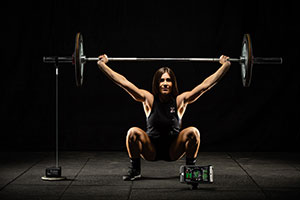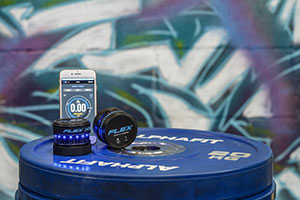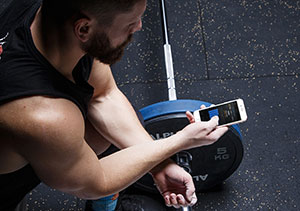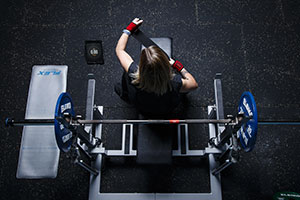 Kinetic Performance Technology was founded in 2002 to bring power monitoring to the weights room.
Kinetic Performance Technology was founded in 2002 to bring power monitoring to the weights room.
Originally the company provided a range of different products including altitude houses for altitude simulation training. However, in the past 7 years they have specialised in providing GymAware, a device which measures the performance of the athlete in the weights room.
According to Kinetic Performance Technology Managing Director, Heather Lawton, GymAware is designed specifically for researchers and teams. It attaches to any barbell and it provides the athlete with real-time feedback on how fast they're moving the bar, how much power they're outputting, and what their bar path looks like.
Heather says that originally the interface and the features were designed purely for teams, but then with the development of technologies over the last five or ten years, like Bluetooth, WiFi and apps that were built for the iPad; the design has evolved to have a real athlete focus.
“From an athlete’s perspective, it provides them with feedback on movements that traditionally you don't get feedback on,” says Heather.
“Coaches were frustrated because it was just one more thing for them to have to do when they went into the gym. The idea that you could empower athletes to run the system so that it gives them what they want, and leaves the coaches free to keep doing the coaching, was well-received. This also corresponded with the increased availability of WiFi in these facilities.
“For coaches, the data enables them to do better programming. We find that a lot of elite athletes train for what is called velocity-based training and that's what our product enables coaches to implement because it's accurate and reliable”.
Heather says that because all the data is collected on their account, club performance managers can monitor what is being done in their program in the strength area. If their team has a win, they can go back and ask why they did so well. If the team is getting a lot of injuries, they can go back over the data and check to see where the problem lies. If it's not in the gym, it may be out on the field. They can then go and look at the GPS data or the wellness data of these athletes to find the source of the problem.
GymAware is used by elite sporting teams internationally and has the largest repository of strength related data worldwide. It is validated by the Australian Institute of Sport and is used extensively in research papers around the world.
Identifying new product lines
 Initially, Kinetic Performance Technology focused on elite sport like the New Zealand All Blacks and the majority of North American professional codes like ice hockey, NFL, basketball and baseball. A lot of their exporting success has also come from the fact that in the United States universities and colleges have strength and conditioning as a really key part of their lifestyle. Whilst GymAware is aimed largely at elite and semi-professional athletes, Heather says that now they are seeing demand from more high-performance facilities like boutique gyms.
Initially, Kinetic Performance Technology focused on elite sport like the New Zealand All Blacks and the majority of North American professional codes like ice hockey, NFL, basketball and baseball. A lot of their exporting success has also come from the fact that in the United States universities and colleges have strength and conditioning as a really key part of their lifestyle. Whilst GymAware is aimed largely at elite and semi-professional athletes, Heather says that now they are seeing demand from more high-performance facilities like boutique gyms.
To take advantage of this growth over the last few years the team at Kinetic Performance Technology have been researching and prototyping a new product.
“We came out with a product which does what GymAware does, but is designed for individual training. We could see a trend developing, people are wearing Fitbits, counting their steps and everyone is tracking everything. The gym seemed like a very untapped market,” says Heather.
“Because of its accuracy, GymAware wasn't affordable to the everyday person as it originally comes from a scientific background. We needed to make something that was affordable, still high quality but tailored to individuals”.
The impact of the COVID-19 pandemic
They launched their new product, FLEX, in November 2019.
“We had developed a strong marketing roadmap with plans to travel to different trade shows. This all fell in a heap in March when COVID-19 hit,” says Heather.
“But it created a different way to release our product to the market. We approached most of the Australian rugby teams and sent them this new individual product. This meant that they could train with it at home. Then we built some software that bridged the data from those individuals across into what they've been using GymAware for.
“This meant the coaches could access the same data under the same system. We also built in some community features like giving each other fist bumps, being able to see when you're training and comment on your training”.
Harnessing the power of brand ambassadors
 Heather says that once they were able to provide a product that was not cost prohibitive, it had a really interesting uptake.
Heather says that once they were able to provide a product that was not cost prohibitive, it had a really interesting uptake.
“While we didn't want to target the elite market with these products, they provided a really good reference. So, we started approaching YouTube ambassadors and people like that who were lifting and said ‘hey, we've got this product and the Red Sox guys are using it decentralised’. We managed to build a consumer audience of individuals by just reaching out to people on social media and asking if they would try our product”.
While everyone was rushing out trying to buy gym equipment during COVID, it was still challenging trying to launch a new product into the market. Heather says one of the biggest challenges was that traction grew initially through word of mouth and exposure in the social space, but then social media became very noisy.
“Being able to just get your message through to your audience when so much else is going on is hard. People are just posting rubbish because screen time and access to your phone has just gone from zero to out of control.
“We really investigated the people that we were giving our product to and rather than doing Facebook ads and social media ads, we tended to spend that money on those people. It's been interesting in that this has opened up a whole new market for FLEX and it wasn't who we thought it would be”.
FLEX really gained traction with the semi-serious powerlifters.
“They have a real genre about them - the way they dress, the way they train, what they eat. We started to hang out in the spaces that they live in. We found that they are attracted to the sport because it's very analytical, data-based training and very scientific”.
Like GymAware, FLEX measures barbell velocity, power, distance, bar path and bar movement. Every rep is measured and every set is tracked. Real-time lift performance is displayed through the FLEXStronger app which is modern, intuitive and holds the user accountable to session intensity and training zones. FLEX encourages a more social training experience. It means the user can compare results, share with friends and follow the performance of their sporting heroes.
Having the time to really listen to customers
 Heather says it was very important to keep connected with their customers and also understand what they were going through.
Heather says it was very important to keep connected with their customers and also understand what they were going through.
“We had a little more time to spend reaching out to the majority of our customer base because we weren't travelling so much. We just asked them how they were going and whether we could help. It was also an opportunity to talk to them about product functionality. It took people a little while to understand that they could still keep using GymAware, so we spent time educating coaches to show them how they could prescribe remote coaching. The capability had always been there but some coaches had never taken the system to that level.
“People were much more receptive to having Zoom meetings and whilst the time zone was dreadful for us, it's actually been a great way to educate our existing customer base as well as new customers.”
Heather says that the pandemic and some of the challenges it has caused have also provided opportunities for innovation.
“One thing that's come out of it for us is we're about to launch a practitioner online course. Strength and conditioning coaches have to get re-accreditation points each year. There aren't the usual conferences to go to, so by providing a course that a coach does online and is certified they can earn accreditation points. We're about to launch one to coincide with a conference that's happening all online. This is something that we probably wouldn't have done in the past because the majority of our time overseas is spent training groups of staff. It's been good in that I think it breaks that geographical barrier for us”.
Lessons learned
Heather points to a few of the lessons learned over the last few months.
- “I think it's really highlighted that you should always prioritise your relationships with your customers over your profit. I think communicating with your existing customers is really important. For us we looked at customers who were putting up lots of data and asked them about this - what features were they using? Did they want to see anything different? I think it's always important to keep that customer communication loop open”.
- "Always keep looking at what other businesses and other industries, even those that aren't even similar to yours, are doing. Look at what markets have totally boomed since COVID and ask why is that? For example, why can’t you buy a mountain bike now? Mountain bike sales went through the roof as people suddenly had this desire to exercise or to be outside. Also, ask why did some industries totally tank? I also looked at consumer gyms and what were they offering their customers in order to retain their members.
- Find out what support is available. “In the early years we received a startup Knowledge Grant from the ACT Government. That was a really big boost and then we did a round of Trade Connect grants which were excellent when we started exporting. That really gave us the confidence to actually go to the US for the first time. Then we've been accessing the Export Marketers Development grant which has been so helpful. We're looking at paying US$4,000 just to go to a trade show for three days and that's just the base cost of having space. For a small business, depending on what the Aussie dollar is, it can be pretty rough at times. This really helps because with the grant you can cover the cost of shipping demo units to people”.
“We’ve also recently received an Innovation Connect grant to develop a feature set for this new product that can open the high school market to us. They're looking for a more prescriptive product that does the stuff on the barbell, but the coaches want to be able to prescribe what it does. In elite sport you have a software company that does athlete wellness, like sleep and nutrition surveys, then you have another company that does all the training programs, then you have GPS data. An elite team can afford to pay for that kind of spread, whereas a high school just wants one solution. In the US some of the high schools buy GymAware, but we want to be able to offer it to division two and division three high schools that that don't have such big budgets”.
An initiative of the ACT Chief Minister’s Export Awards
The ACT Chief Minister’s Export Awards aims to showcase and celebrate the achievements of Canberra region exporting businesses. These Canberra and region businesses transact significant parts of their business activities (legal, accounting, production, research etc.) through the ACT as they develop international markets. The ACT Chief Minister’s Export Awards aims to build the pathway for new and emerging Canberra region businesses seeking to internationalise their business. If you are a new or existing exporting businesses in the Canberra region, you can access a range of support as well as network with other exporting businesses, including
The ACT TradeStart Program helps ACT exporters to achieve long term success in international markets. The TradeStart program allows the ACT Government to work closely with Austrade and access key Austrade resources such as their export database, trade mission activities, their off-shore offices, intelligence and international connections for the trade and investment activities to support ACT exporters.
The International Business Engagement Program is being delivered by Canberra Business Chamber on behalf of the ACT Government. Its main objective is to maintain, rebuild and find new opportunities for Canberra and region businesses to engage internationally. The program focuses on building the Territory’s exporting community; providing training and support by facilitating seminars and workshops; creating links between local industry and other government support programs; assisting the ACT Government in co-ordination of business trade delegations (outbound and inbound).


